Introduction:
DNA, a type of nucleic acid, is the genetic substance that gives each cell its unique identity. Biomolecules and organelles must be copied before a cell replicates and divides into new daughter cells during mitosis or meiosis which is required for cell growth, repair, and reproduction in all living creatures.
The DNA which is localized in nucleus must be reproduced in order for each new cell to receive the correct number of chromosomes. DNA replication is the molecular event which involve duplicating DNA actually occurs in the S phase of interphase during the cell cycle in eukaryotic cells including animal cells and plant cells. The replication process involves numerous proteins known as replication enzymes as well as RNA.
Because DNA replication is such an important process, the cell proofreads newly manufactured DNA to ensure that no errors or mutations are added. After a cell’s DNA has been duplicated, it can divide into two cells, each with an identical copy of the original DNA.
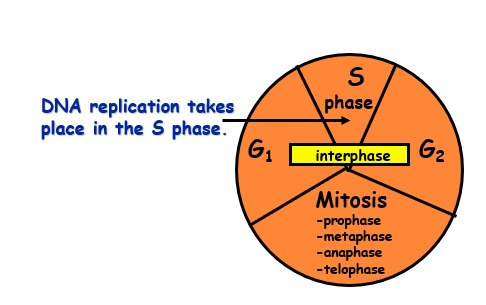
Fig: DNA synthesis in the S phase of cell cycle
Different model of DNA Replication:
Three form of DNA replication can be notable: conservative, semiconservative, dispersive.
Semi-conservative replication
The two parental strands of DNA unwrap from one another in this concept, and each serve as a template for the synthesis of a new, complimentary strand. Two DNA molecules, one with the original strand and the other with the new strand, are synthesized. The two daughter molecules have one old and one new strand each after one cycle of replication. Two of the DNA molecules contain exclusively new material after two rounds, whereas the other two contain one old and one new strand.
Conservative replication
In this theory, DNA replication produces one molecule with both original DNA strands (similar to the original DNA molecule) and another molecule with two new strands (with exactly the same sequences as the original molecule).
Dispersive replication
DNA replication in the dispersive model produces two DNA molecules that are combinations of parental and daughter DNA, referred to as “hybrids.” Each strand is made up of a mix of old and fresh DNA in this concept.
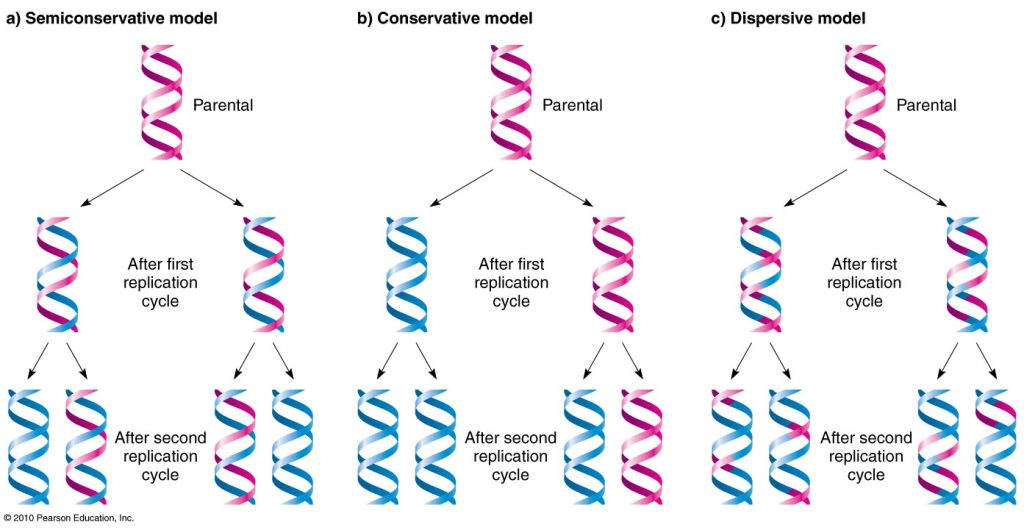
Fig: Different model of DNA replication
The semi-conservative hypothesis is perhaps the most apparent, because separating the two strands yields two templates, each of which contains all of the information from the original molecule. Given the structure of the DNA double helix, where the two DNA strands are completely, predictably complementary to one another (when one contains a T, the other has an A; etc.), this idea made a lot of sense. It was simple to picture each strand as a template for the synthesis of a new partner because of this interaction. In the 1950s, Matthew Stanley Meselson and Franklin William Stahl in the U. S. demonstrated semi-conservative DNA replication, in which each daughter DNA molecule contains one new daughter subunit and one subunit conserved from the parental DNA molecule, in an experiment that was later named after them.
From October 1957 to January 1958, the researchers conducted the experiment at the California Institute of Technology (Caltech) in Pasadena, California. The result supported James Watson and Francis Crick’s concept for DNA structure, which portrayed DNA as a double helix made up of two helical strands that replicated semi-conservatively. The Watson-Crick Model for DNA was later adopted as the universal DNA model. Researchers were able to explain how DNA repeats owing to the Meselson-Stahl experiment, which provided a physical basis for the genetic phenomena of heredity and disorders.
Requirements:
DNA replication would not be possible without the enzymes that catalyze different steps in the process. DNA replication process is aided by the following enzymes:

Fig: Different components required for DNA Replication
DNA helicase
As it proceeds along the DNA, the DNA helicase unwinds and splits double-stranded DNA. By breaking hydrogen bonds between nucleotide pairs in DNA, it creates the replication fork.
DNA Primase
RNA primers are created by DNA primase, a form of RNA polymerase. Primers are small RNA molecules that serve as templates for the replication of DNA.
DNA polymerase III
It adds nucleotides to the leading and lagging DNA strands to form new DNA molecules.
DNA polymerase I
RNA primers are removed and replaced with DNA primers by DNA polymerase I.
DNA Sliding clamp
It is also known as a proliferating cell nuclear antigen (PCNA) that allow the stable binding of DNA Pol and strand synthesis.
Single-strand binding proteins (SSB)
During DNA replication, the single-stranded DNA binding protein (SSB) wraps single-stranded DNA (ssDNA) with high affinity to protect it from degradation and prevent secondary structure formation.
RNA Primer
It is a short nucleic acid sequence that serves as a starting point for DNA synthesis.
Topoisomerase
It is also known as DNA Gyrase, unwinds and rewinds DNA strands to prevent tangles and supercoils.
Exonucleases
They are a group of enzymes that are responsible for removing nucleotide bases from the end of a DNA strand.
DNA ligase
This is a protein that forms phosphodiester linkages between nucleotides to bind DNA fragments together.
Steps in DNA replication:
Step 1: Formation of Replication Fork
The un-replicated DNA is unwound by an enzyme called helicase, which breaks the hydrogen bonds between the nitrogenous base pairs. This mechanism required ATP hydrolysis. As the DNA opens up, replication forks form Y-shaped structures.
Meanwhile, while the helicase divides the strands, another enzyme called primase attaches itself to each strand for a short period of time and builds a foundation on which replication can begin. A primer is a short sequence of nucleotides that serves as a framework.
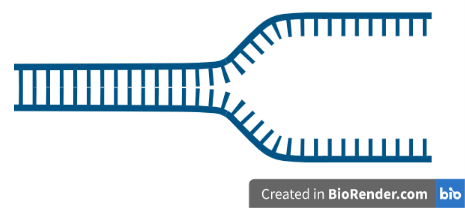
Fig: Formation of replication fork
Step 2: Initiation
The most basic mechanism of DNA replication appeared to be the constant growth of both new strands at the replication fork as it moved from one end of a DNA molecule to the other, nucleotide by nucleotide. This method would require one daughter strand to polymerize in the 5′-to-3′ direction and the other in the 3′-to-5′ direction due to the antiparallel arrangement of the two DNA strands in the DNA double helix. Two separate DNA polymerase enzymes would be needed for this replication fork.
Each incoming deoxyribonucleoside triphosphate carrying the triphosphate activation needed for its own addition would polymerize in the 5′-to-3′ orientation. The other would travel in the 3′-to-5′ direction and work through “head growth,” in which the triphosphate activation required for the addition of each subsequent nucleotide was carried at the end of the extending DNA chain.
Step 3: Elongation
The polymerase enzymes begin building the complementary sequence in each strand as the strands are separated. The parental strands will serve as a template for the daughter strands as they synthesize.
It’s important to remember that elongation is unidirectional, meaning that DNA is only polymerized in one direction: 5′ to 3′. As a result, continuous replication (Leading Strand) occurs on one strand (the template 3’5′), whereas discontinuous replication occurs on the other strand (the template 5’3′). They appear in the form of Okazaki fragments (lagging Strand). Later, the enzyme DNA ligase binds them.
The short RNA primers’ RNA nucleotides must be removed and replaced with DNA nucleotides, which are then linked together by the DNA ligase enzyme.
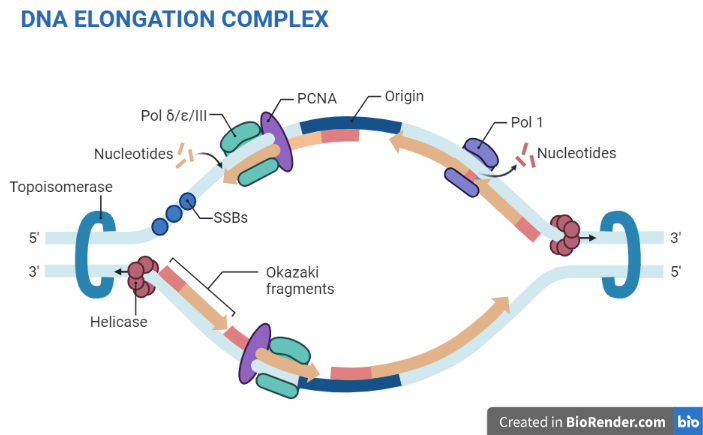
Fig: DNA elongation complex
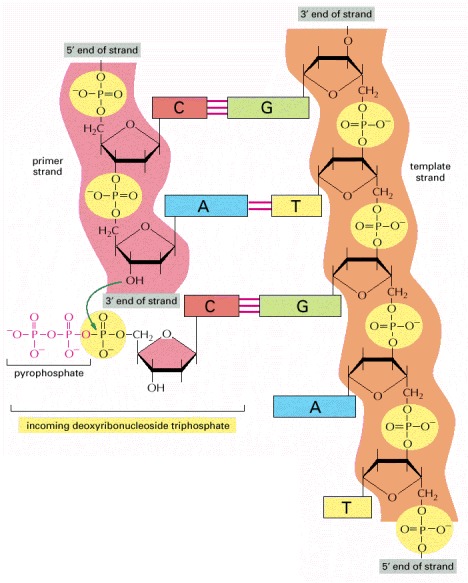
Fig: Basic chemistry of DNA replication
Step 4: Termination
Exonuclease, an enzyme, eliminates all RNA primers from the original strands after the production and expansion of both the continuous and discontinued stands. The incorrect nucleotide bases are substituted for the primers. Another type of exonuclease proofread the new stands while removing the primers, checking, correcting, and replacing any errors that occurred during the synthesis.
The Okazaki fragments are then joined together by the DNA ligase enzyme to form a single strand.
The parent strand’s ends are made up of a repeat of DNA sequences known as telomeres, which operate as protective caps at the ends of chromosomes, preventing chromosomes from uniting. Telomeres are made by the telomerase enzyme, which is a type of DNA polymerase enzyme. The telomere sequences at the end of the DNA are catalyzed by it.
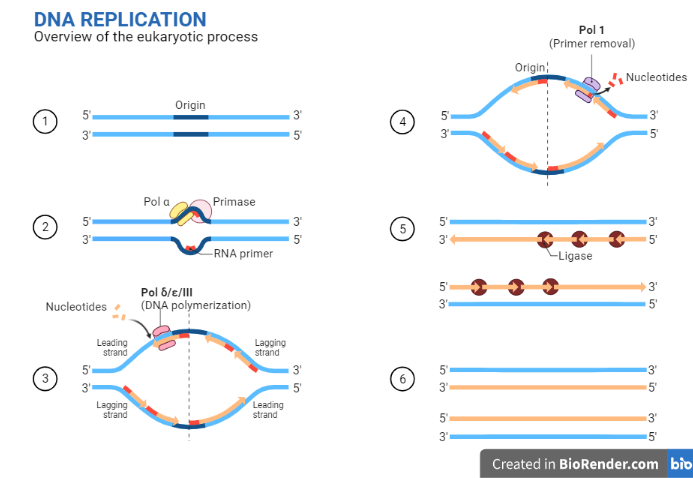
Fig: overview of DNA replication
Significance:
The process of duplicating a double-stranded DNA molecule into two identical DNA molecules is known as DNA replication which is vital in maintaining species variability.
DNA includes all of the information necessary for an existence of cell, including instructions for producing proteins and enzymes. When a cell divides, it’s crucial that the two new daughter cells have the same chromosome set as the parent cell. Without replication, the daughter cells would be unable to produce the necessary protein synthesis machinery. This could cause major complications.
Error in DNA replication:
Although DNA replication is an extremely accurate process, errors such as a DNA polymerase inserting the incorrect nucleotide can exist. Uncorrected errors can have devastating outcomes, such as cancer, if they are not fixed. Errors are repaired through various types of DNA repair mechanisms. Are such errors aren’t rectified, it will eventually lead to mutation. In some circumstances, repair enzymes are mutated or dysfunctional.
DNA replication and repair are critical processes that ensure that a biological system’s genetic material is maintained. DNA is replicated and divided on a continuous basis, and errors can occur throughout this process. It is critical for the biological system to have a mechanism to detect and address these defects.
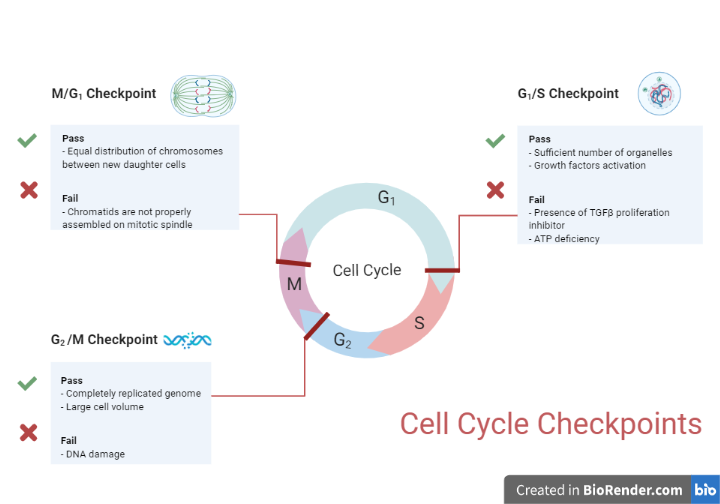
Fig: cell cycle checkpoints
Each checkpoint acts as a potential cell cycle termination point, during which the cell’s conditions are examined and only when favorable conditions are fulfilled does the cell cycle advance through the various phases.
Human genetic abnormalities reveal evidence of the significance of proofreading and repair systems. Heredity malignancies like Lynch disease and xeroderma pigmentosum are frequently linked to mutations in genes that code for proofreading and repair proteins.
Key points:
- Semiconservative replication is a term used to describe the way DNA is replicated. Each of the double helical strands serves as a template for the synthesis of a new complementary strand.
- It is critical that DNA be duplicated when a cell splits into daughter cells since DNA holds an organism’s genetic material. This event that refers to the process of copying DNA is known as DNA replication.
- DNA polymerases are enzymes that synthesis DNA in the 5′ to 3′ orientation, using a template and a primer (starter).
- One new strand (the leading strand) is created as a single piece during DNA replication. The other is made up of smaller fragments (the lagging strand).
- Other enzymes, including as DNA primase, DNA helicase, DNA ligase, and topoisomerase, are required for DNA replication in addition to DNA polymerase.
- In organisms, the total DNA replication process is crucial for cell development and reproduction which is also important for cell repair.
References:
- Albert, B., Johnson, A., Lewis, J., Raff, M., Roberts, K. and Walter, P., 2000. Molecular biology of the cell 4th edition (New York, Garland Science).
- Prescott, L.M., 2002. Microbiology.
- Sabatinos, S.A., 2010. Replication fork stalling and the fork protection complex. Nature Education, 3(9), p.40.

